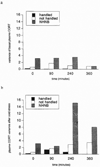Abnormal corticosterone regulation in an immature rat model of continuous chronic stress
- PMID: 8888044
- PMCID: PMC3415889
- DOI: 10.1016/0887-8994(96)00153-1
Abnormal corticosterone regulation in an immature rat model of continuous chronic stress
Abstract
Neuroendocrine correlates of chronic stress in human infants have not been established. The goal of the present study was to create an animal model of continuous chronic stress using the immature rat to measure basal plasma corticosterone, and secretion of plasma corticosterone in response to an acute stress. This was achieved by modulation of the cage environment for rat pups and their mothers. During postnatal days 2-9, pups were maintained in three groups: (1) handled, (2) not handled and with ample bedding; and (3) not handled with limited bedding. On postnatal day 9, some pups from each group were subjected to acute cold-separation stress and were killed 90, 240, or 360 min later along with unstressed controls. The group not handled and with limited bedding manifested increased plasma corticosterone output even without cold exposure and a sustained increase of plasma corticosterone after cold-separation stress. Plasma corticosterone interanimal variability was increased and body weight was decreased in these pups, typical of a state of chronic stress. The first model of continuous stress in infant rats in which upregulation of hypothalamic-pituitary-adrenal axis is achieved without maternal separation is presented. This paradigm may more closely approximate the human situation of chronically stressed, neglected infants.
Figures




Similar articles
-
The newborn rat's stress system readily habituates to repeated and prolonged maternal separation, while continuing to respond to stressors in context dependent fashion.Horm Behav. 2011 Jul;60(2):165-76. doi: 10.1016/j.yhbeh.2011.04.003. Epub 2011 May 3. Horm Behav. 2011. PMID: 21570400
-
Interaction with stressed mothers affects corticosterone levels in pups after reunion and impairs the response to dexamethasone in adult mice.Psychoneuroendocrinology. 2008 May;33(4):462-70. doi: 10.1016/j.psyneuen.2008.01.003. Epub 2008 Mar 4. Psychoneuroendocrinology. 2008. PMID: 18308478
-
Periodic maternal separation decreases hippocampal neurogenesis without affecting basal corticosterone during the stress hyporesponsive period, but alters HPA axis and coping behavior in adulthood.Psychoneuroendocrinology. 2012 Mar;37(3):410-20. doi: 10.1016/j.psyneuen.2011.07.011. Epub 2011 Aug 20. Psychoneuroendocrinology. 2012. PMID: 21862224
-
Relation between the hypothalamic-pituitary-thyroid (HPT) axis and the hypothalamic-pituitary-adrenal (HPA) axis during repeated stress.Neuroendocrinology. 2005;81(3):183-92. doi: 10.1159/000087001. Epub 2005 Jul 11. Neuroendocrinology. 2005. PMID: 16020927
-
Stress and the developing limbic-hypothalamic-pituitary-adrenal axis.Psychoneuroendocrinology. 1998 Oct;23(7):663-700. doi: 10.1016/s0306-4530(98)00029-8. Psychoneuroendocrinology. 1998. PMID: 9854741 Review.
Cited by
-
A role for gut microbiota in early-life stress-induced widespread muscle pain in the adult rat.Mol Pain. 2021 Jan-Dec;17:17448069211022952. doi: 10.1177/17448069211022952. Mol Pain. 2021. PMID: 34096398 Free PMC article.
-
The effects of early life adversity on growth, maturation, and steroid hormones in male and female rats.Eur J Neurosci. 2020 Jul;52(1):2664-2680. doi: 10.1111/ejn.14609. Epub 2019 Nov 24. Eur J Neurosci. 2020. PMID: 31660665 Free PMC article.
-
Type of early life adversity confers differential, sex-dependent effects on early maturational milestones in mice.Horm Behav. 2020 Aug;124:104763. doi: 10.1016/j.yhbeh.2020.104763. Epub 2020 May 25. Horm Behav. 2020. PMID: 32407728 Free PMC article.
-
Influence of maternal care on the developing brain: Mechanisms, temporal dynamics and sensitive periods.Front Neuroendocrinol. 2016 Jan;40:52-66. doi: 10.1016/j.yfrne.2015.11.001. Epub 2015 Nov 23. Front Neuroendocrinol. 2016. PMID: 26616341 Free PMC article. Review.
-
Changes in Environmental Stress over COVID-19 Pandemic Likely Contributed to Failure to Replicate Adiposity Phenotype Associated with Krtcap3.bioRxiv [Preprint]. 2023 Jun 25:2023.03.15.532439. doi: 10.1101/2023.03.15.532439. bioRxiv. 2023. Update in: Physiol Genomics. 2023 Oct 1;55(10):452-467. doi: 10.1152/physiolgenomics.00019.2023. PMID: 36993361 Free PMC article. Updated. Preprint.
References
-
- Gold P, Goodwin F, Chrousos C. Clinical and biochemical manifestations of depression. II. Relation to the neurobiology of stress. N Engl J Med. 1988;319:413–420. - PubMed
-
- Owens M, Nemeroff C. The role of CRF in the pathophysiology of affective and anxiety disorders: Laboratory and clinical studies. In: Chadwick DJ, Marsh J, Ackrill K, editors. Corticotropin Releasing Factor. Chichester: John Wiley and Sons; 1993. pp. 296–316.
-
- Money J. The syndrome of abuse dwarfism (psychosocial dwarfism or reversible hyposomatotropism) Am J Dis Child. 1977;131:508–513. - PubMed
-
- Dietrich KN, Starr RH, Weisfeld GE. Infant maltreatment: Caretaker-infant interaction and developmental consequences at different levels of parenting failure. Pediatrics. 1983;72:532–540. - PubMed
-
- Powell GF, Bettes BA. Infantile depression, nonorganic failure to thrive, and DSM III-R: A different perspective. Child Psychiatry Hum Dev. 1992;22:185–198. - PubMed

